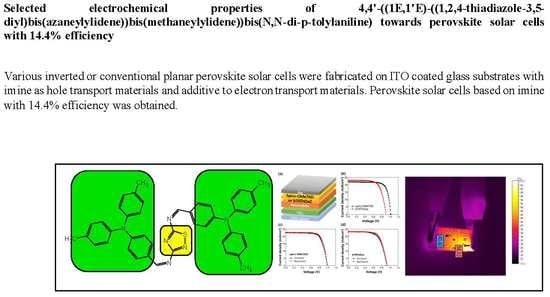Selected Electrochemical Properties of 4,4’-((1E,1’E)-((1,2,4-Thiadiazole-3,5-diyl)bis(azaneylylidene))bis(methaneylylidene))bis(N,N-di-p-tolylaniline) towards Perovskite Solar Cells with 14.4% Efficiency
Abstract
1. Introduction
- Organic HTMs including polymers (poly(3-hexylthiophene): P3HT, poly(3,4-ethylenedioxythiophene): PEDOT, crosslinked polymers) and small molecular materials (spiro-OMeTAD, pyrene-, thiophene-, carbazole-, porphyrin derivatives) based HTMs,
- Inorganic HTMs combine nickel and copper-based HTMs (NiO, CuO, CuSCN, CuCrO2, CuGaO2), p-type based semiconductor HTMs (such as organometallic complexes, e.g., coper phthalocyanine or coper thiocyanate- based HTMs), and transition metal oxide based HTMs (MoO3, VOx, WOx),
- Carbonaceous based HTMs (graphene oxide based HTMs).
2. Experimental Section
2.1. Deposition of Thin-Film
2.2. Construction of Perovskite Solar Cells with bTAThDaz as HTM
3. Results and Discussion
3.1. Synthesis and Purification of bTAThDaz
3.2. Optical and Electrochemical Studies
3.3. Electrical Properties of Imine and Simple Devices together with Surface Morphology Checked by SEM and Thermographic Camera
3.4. Perovskite Solar Cells with bTAThDaz
4. Conclusions
Supplementary Materials
Author Contributions
Funding
Conflicts of Interest
References
- Jena, A.K.; Kulkarni, A.; Miyasaka, T. Halide Perovskite Photovoltaics: Background, Status, and Future Prospects. Chem. Rev. 2019, 119, 3036–3103. [Google Scholar] [CrossRef] [PubMed]
- Nayak, P.K.; Mahesh, S.; Snaith, H.J.; Cahen, D. Photovoltaic Solar Cell technologies: Analysing the State of the Art. Nat. Rev. Mater. 2019, 4, 269–285. [Google Scholar] [CrossRef]
- Kavan, L. Electrochemistry and Dye-sensitized Solar Cells. Curr. Opin. Electrochem. 2017, 2, 88–96. [Google Scholar] [CrossRef]
- Kavan, L. Electrochemistry and perovskite photovoltaics. Curr. Opin. Electrochem. 2018, 11, 122–129. [Google Scholar] [CrossRef]
- Kavan, L.; Zivcova, Z.V.; Hubik, P.; Arora, N.; Dar, M.I.; Zakeeruddin, S.M.; Grätzel, M. Electrochemical Characterization of CuSCN Hole-Extracting Thin Films for Perovskite Photovoltaics. ACS Appl. Energy Mater. 2019, 2, 4264–4273. [Google Scholar] [CrossRef]
- Petrus, M.L.; Bein, T.; Dingemans, T.; Docampo, P. A low cost azomethine-based hole transporting material for perovskite photovoltaics. J. Mater. Chem. A 2015, 3, 12159–12162. [Google Scholar] [CrossRef]
- Osedach, T.P.; Andrew, T.L.; Bulović, V. Effect of synthetic accessibility on the commercial viability of organic photovoltaics. Energy Environ. Sci. 2013, 6, 711. [Google Scholar] [CrossRef]
- Pitchaiya, S.; Natarajan, M.; Santhanam, A.; Asokan, V.; Yuvapragasam, A.; Ramakrishnan, V.R.M.; Palanisamy, S.E.; Sundaram, S.; Velauthapillai, D. A review on the classification of organic/inorganic/carbonaceous hole transporting materials for perovskite solar cell application. Arab. J. Chem. 2020, 13, 2526–2557. [Google Scholar] [CrossRef]
- Zhao, X.; Wang, M. Organic hole-transporting materials for efficient perovskite solar cells. Mater. Today Energy 2018, 7, 208–220. [Google Scholar] [CrossRef]
- Assadi, M.K.; Bakhoda, S.; Saidur, R.; Hanaei, H. Recent progress in perovskite solar cells. Renew. Sustain. Energy Rev. 2018, 81, 2812–2822. [Google Scholar] [CrossRef]
- Mesquita, I.; Andrade, L.; Mendes, A.M. Perovskite solar cells: Materials, configurations and stability. Renew. Sustain. Energy Rev. 2018, 82, 2471–2489. [Google Scholar] [CrossRef]
- Yang, X.; Wang, H.; Cai, B.; Yu, Z.; Sun, L. Progress in hole-transporting materials for perovskite solar cells. J. Energy Chem. 2018, 27, 650–672. [Google Scholar] [CrossRef]
- Bakr, Z.H.; Wali, Q.; Fakharuddin, A.; Schmidt-Mende, L.; Brown, T.M.; Jose, R. Advances in hole transport materials engineering for stable and efficient perovskite solar cells. Nano Energy 2017, 34, 271–305. [Google Scholar] [CrossRef]
- Rodríguez-Seco, C.; Cabau, L.; Vidal-Ferran, A.; Palomares, E. Advances in the Synthesis of Small Molecules as Hole Transport Materials for Lead Halide Perovskite Solar Cells. Acc. Chem. Res. 2018, 51, 869–880. [Google Scholar] [CrossRef] [PubMed]
- Petrus, M.L.; Morgenstern, F.S.F.; Sadhanala, A.; Friend, R.H.; Greenham, N.C.; Dingemans, T. Device Performance of Small-Molecule Azomethine-Based Bulk Heterojunction Solar Cells. Chem. Mater. 2015, 27, 2990–2997. [Google Scholar] [CrossRef]
- Zhang, F.; Wang, Z.; Zhu, H.; Pellet, N.; Luo, J.; Yi, C.; Liu, X.; Liu, H.; Wang, S.; Li, X.; et al. Over 20% PCE perovskite solar cells with superior stability achieved by novel and low-cost hole-transporting materials. Nano Energy 2017, 41, 469–475. [Google Scholar] [CrossRef]
- Magomedov, A.; Al-Ashouri, A.; Kasparavicius, E.; Strazdaite, S.; Niaura, G.; Jošt, M.; Malinauskas, T.; Rech, B.; Getautis, V. Hole Transporting Monolayers: Self-Assembled Hole Transporting Monolayer for Highly Efficient Perovskite Solar Cells. Adv. Energy Mater. 2018, 8, 1870139. [Google Scholar] [CrossRef]
- Saliba, M.; Orlandi, S.; Matsui, T.; Aghazada, S.; Cavazzini, M.; Correa-Baena, J.-P.; Gao, P.; Scopelliti, R.; Mosconi, E.; Dahmen, K.-H.; et al. A molecularly engineered hole-transporting material for efficient perovskite solar cells. Nat. Energy 2016, 1, 15017. [Google Scholar] [CrossRef]
- Ma, B.-B.; Zhang, H.; Wang, Y.; Peng, Y.-X.; Huang, W.; Wang, M.; Shen, Y. Visualized acid–base discoloration and optoelectronic investigations of azines and azomethines having double 4-[N,N-di(4-methoxyphenyl)amino]phenyl terminals. J. Mater. Chem. C 2015, 3, 7748–7755. [Google Scholar] [CrossRef]
- Gawlinska, K.; Iwan, A.; Starowicz, Z.; Kulesza-Matlak, G.; Stan-Glowinska, K.; Janusz-Skuza, M.; Lipiński, M.; Boharewicz, B.; Tazbir, I.; Sikora, A. Searching of new, cheap, air- and thermally stable hole transporting materials for perovskite solar cells. Opto-Electron. Rev. 2017, 25, 274–284. [Google Scholar] [CrossRef]
- Nádazdy, V.; Schauer, F.; Gmucová, K. Energy resolved electrochemical impedance spectroscopy for electronic structure mapping in organic semiconductors. Appl. Phys. Lett. 2014, 105, 142109. [Google Scholar] [CrossRef]
- Schauer, F.; Nadazdy, V.; Gmucová, K. Electrochemical impedance spectroscopy for study of electronic structure in disordered organic semiconductors—Possibilities and limitations. J. Appl. Phys. 2018, 123, 161590. [Google Scholar] [CrossRef]
- Różycka, A.; Bogdanowicz, K.A.; Górska, N.; Rysz, J.; Marzec, M.; Iwan, A.; Pich, R.; Januszko, A. Influence of TiO2 Nanoparticles on Liquid Crystalline, Structural and Electrochemical Properties of (8Z)-N-(4-((Z)-(4-pentylphenylimino)methyl) benzylidene)-4-pentylbenzenamine. Materials 2019, 12, 1097. [Google Scholar] [CrossRef] [PubMed]
- Bogdanowicz, K.A.; Iwan, A. Symetryczne Iminy i Sposób ich Otrzymywania. Polish Patent Application P.428808, 4 February 2019. [Google Scholar]
- Gonciarz, A.; Pich, R.; Bogdanowicz, K.A.; Jewloszewicz, B.; Przybył, W.; Dysz, K.; Dylong, A.; Kwak, A.; Kaim, A.; Iwan, A.; et al. UV–Vis Absorption Properties of New Aromatic Imines and Their Compositions with Poly({4,8-bis[(2-Ethylhexyl)oxy]Benzo[1,2-b:4,5-b0]Dithiophene-2,6-diyl}{3-Fluoro-2-[(2-Ethylhexyl)Carbonyl]Thieno[3,4-b]Thiophenediyl}). Materials 2019, 12, 4191. [Google Scholar] [CrossRef] [PubMed]
- Zweckmair, T.; Hell, S.; Klinger, K.M.; Rosenau, T.; Potthast, A.; Böhmdorfer, S. Recycling of Analytical Grade Solvents on a Lab Scale with a Purpose-Built Temperature-Controlled Distillation Unit Organic Process. Res. Dev. 2017, 21, 578–584. [Google Scholar]
- Kavan, L. Conduction band engineering in semiconducting oxides (TiO2, SnO2): Applications in perovskite photovoltaics and beyond. Catal. Today 2019, 328, 50–56. [Google Scholar] [CrossRef]
- Schölin, R.; Karlsson, M.H.; Eriksson, S.K.; Siegbahn, H.; Johansson, E.M.J.; Rensmo, H. Energy Level Shifts in Spiro-OMeTAD Molecular Thin Films When Adding Li-TFSI. J. Phys. Chem. C 2012, 116, 26300–26305. [Google Scholar] [CrossRef]
- Zhang, J.; Xu, L.J.; Huang, P.; Zhou, Y.; Zhu, Y.Y.; Yuan, N.; Ding, J.N.; Zhang, Z.; Li, Y.F. A simple and dopant-free hole-transporting material based on (2-ethylhexyl)-9H-carbazole for efficient planar perovskite solar cells. J. Mater. Chem. C 2017, 5, 12752–12757. [Google Scholar] [CrossRef]
- Bujak, P.; Kulszewicz-Bajer, I.; Zagorska, M.; Maurel, V.; Wielgus, I.; Pron, A. Polymers for electronics and spintronics. Chem. Soc. Rev. 2013, 42, 8895. [Google Scholar] [CrossRef]
- Kurowska, A.; Kostyuchenko, A.; Zassowski, P.; Skorka, L.; Yurpalov, V.L.; Fisyuk, A.S.; Pron, A.; Domagala, W. Symmetrically Disubstituted Bithiophene Derivatives of 1,3,4-Oxadiazole, 1,3,4-Thiadiazole, and 1,2,4-Triazole—Spectroscopic, Electrochemical, and Spectroelectrochemical Properties. J. Phys. Chem. C 2014, 118, 25176–25189. [Google Scholar] [CrossRef]
- Gmucová, K.; Nádazdy, V.; Schauer, F.; Kaiser, M.; Majkova, E. Electrochemical Spectroscopic Methods for the Fine Band Gap Electronic Structure Mapping in Organic Semiconductors. J. Phys. Chem. C 2015, 119, 15926–15934. [Google Scholar] [CrossRef]
- Sharifzadeh, S.; Biller, A.; Kronik, L.; Neaton, J.B. Quasiparticle and optical spectroscopy of the organic semiconductors pentacene and PTCDA from first principles. Phys. Rev. B 2012, 85, 125307. [Google Scholar] [CrossRef]
- Chen, C.; Zhang, W.; Cong, J.; Cheng, M.; Zhang, B.; Chen, H.; Liu, P.; Li, R.; Safdari, M.; Kloo, L.; et al. Cu(II) Complexes as p-Type Dopants in Efficient Perovskite Solar Cells. ACS Energy Lett. 2017, 2, 497–503. [Google Scholar] [CrossRef]
- Steim, R.; Choulis, S.A.; Schilinsky, P.; Lemmer, U.; Brabec, C.J. Formation and impact of hot spots on the performance of organic photovoltaic cells. Appl. Phys. Lett. 2009, 94, 43304. [Google Scholar] [CrossRef]
- Hepp, J.; Machui, F.; Egelhaaf, H.-J.; Brabec, C.J.; Vetter, A. Automatized analysis of IR-images of photovoltaic modules and its use for quality control of solar cells. Energy Sci. Eng. 2016, 4, 363–371. [Google Scholar] [CrossRef]
- Hoppe, H.; Bachmann, J.; Muhsin, B.; Drüe, K.-H.; Riedel, I.; Gobsch, G.; Buerhop-Lutz, C.; Brabec, C.J.; Dyakonov, V. Quality control of polymer solar modules by lock-in thermography. J. Appl. Phys. 2010, 107, 014505. [Google Scholar] [CrossRef]
- Bachmann, J.; Buerhop-Lutz, C.; Deibel, C.; Riedel, I.; Hoppe, H.; Brabec, C.J.; Dyakonov, V. Organic solar cells characterized by dark lock-in thermography. Sol. Energy Mater. Sol. Cells 2010, 94, 642–647. [Google Scholar] [CrossRef]
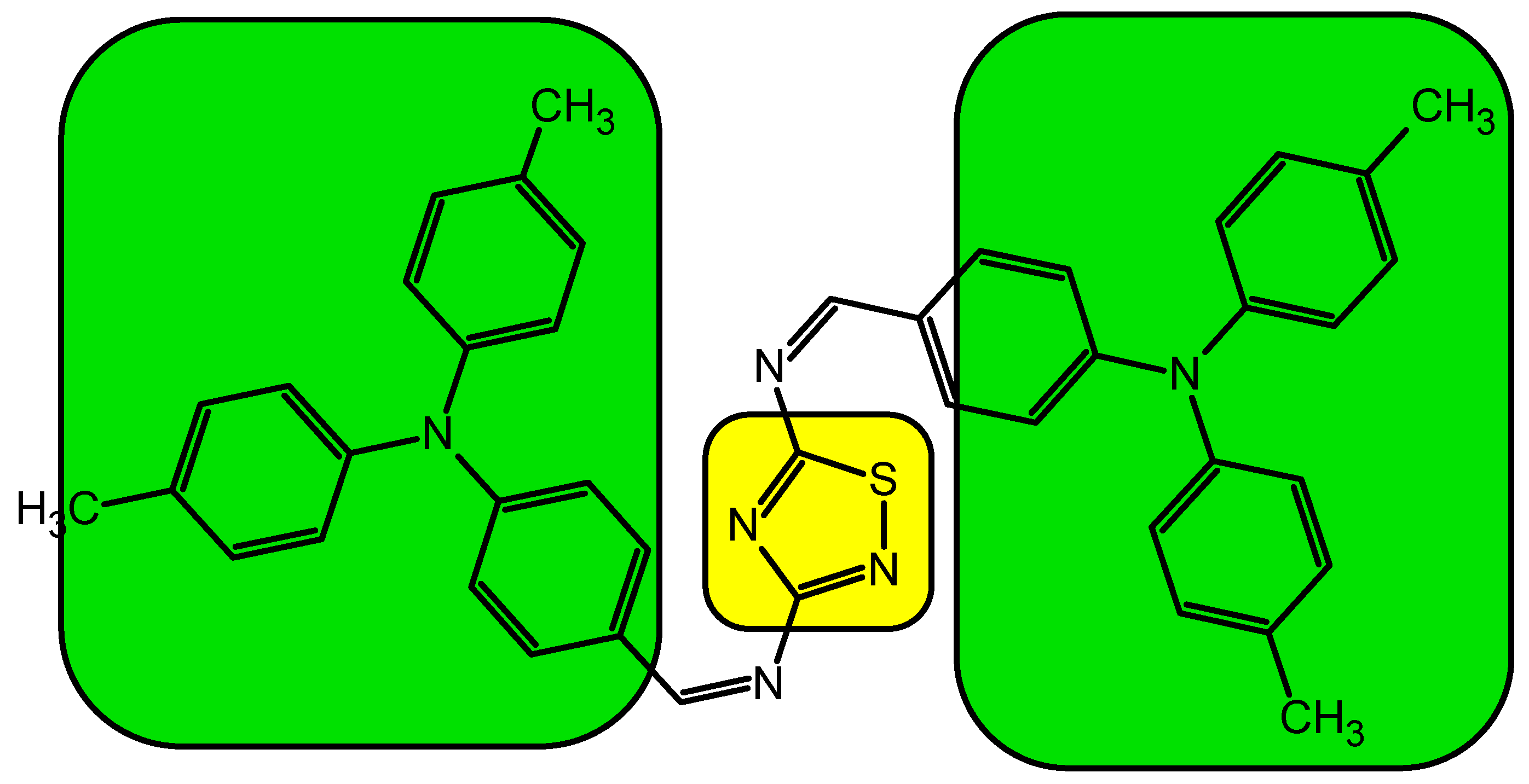

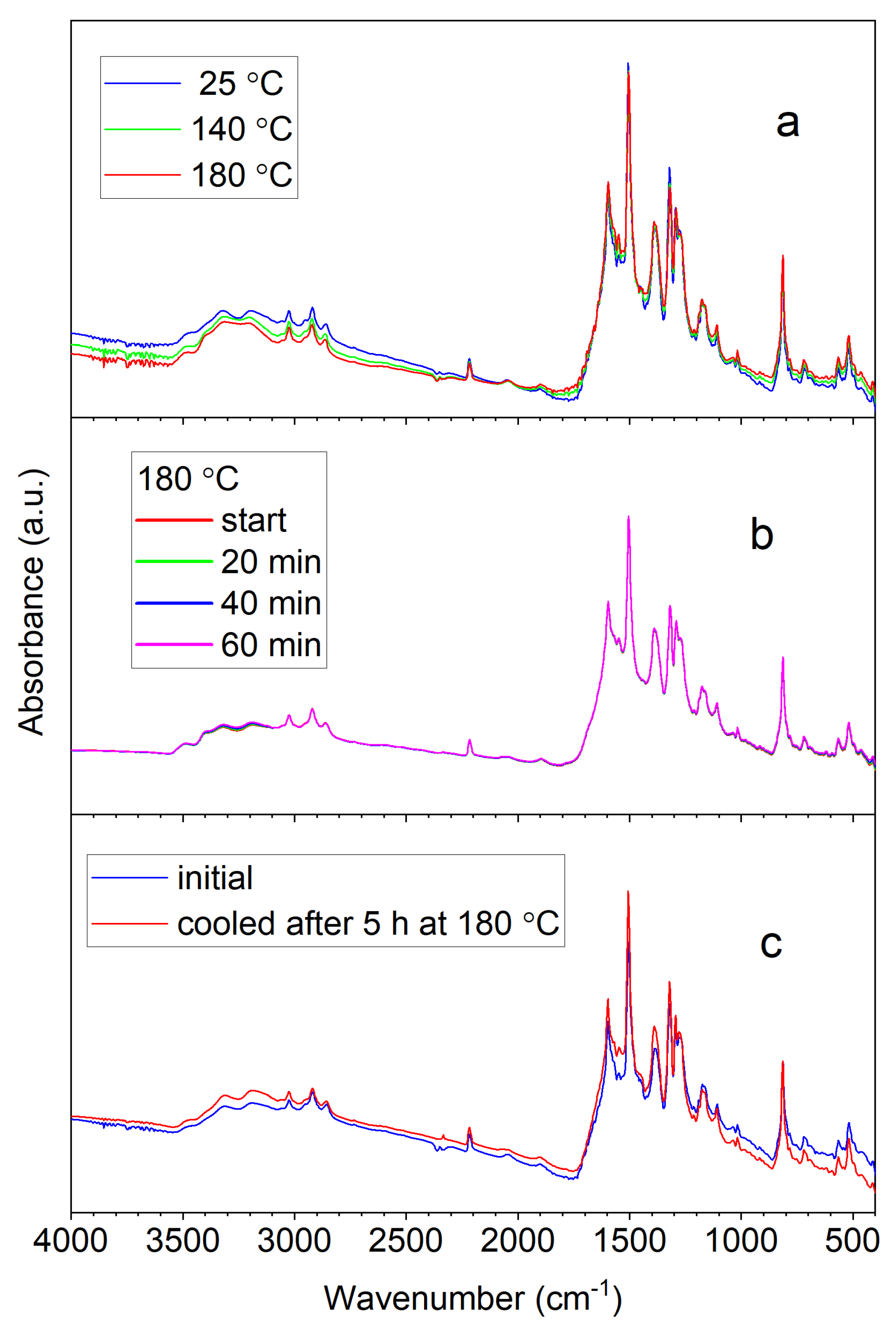





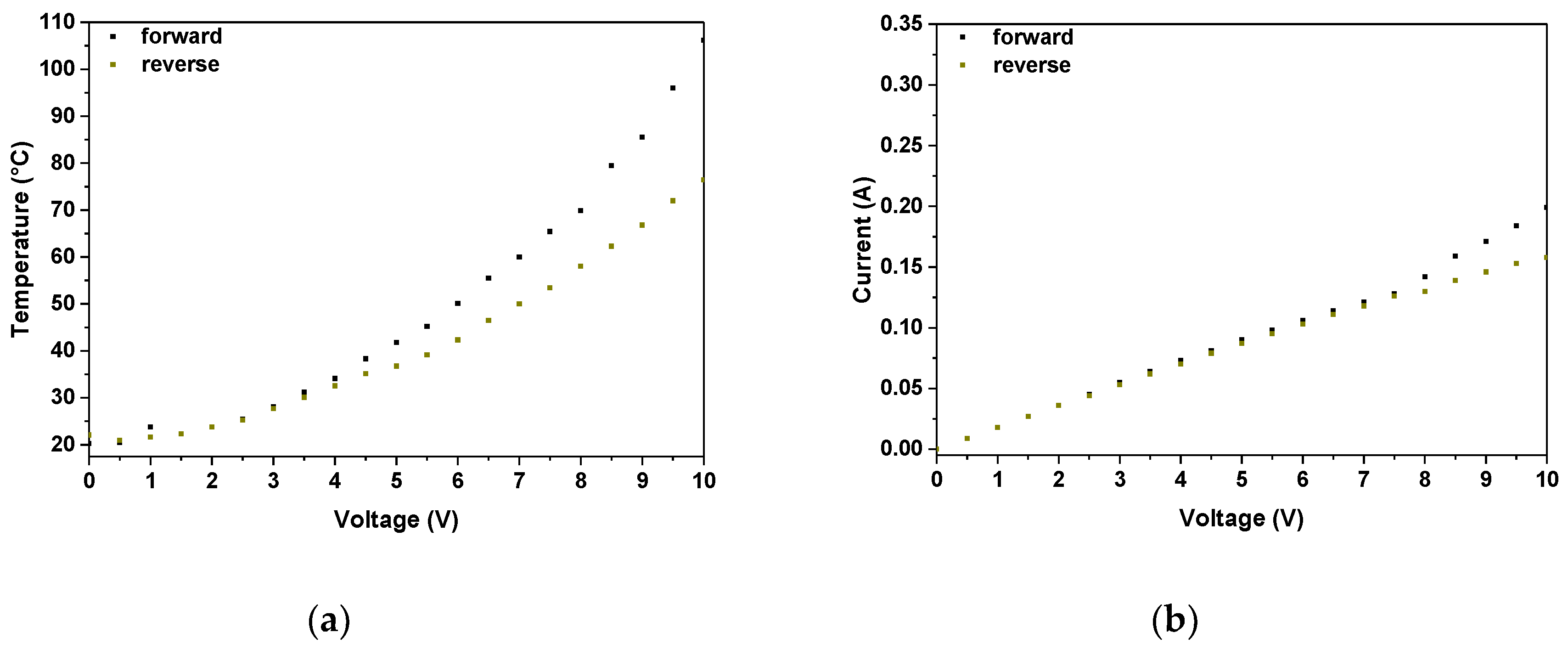
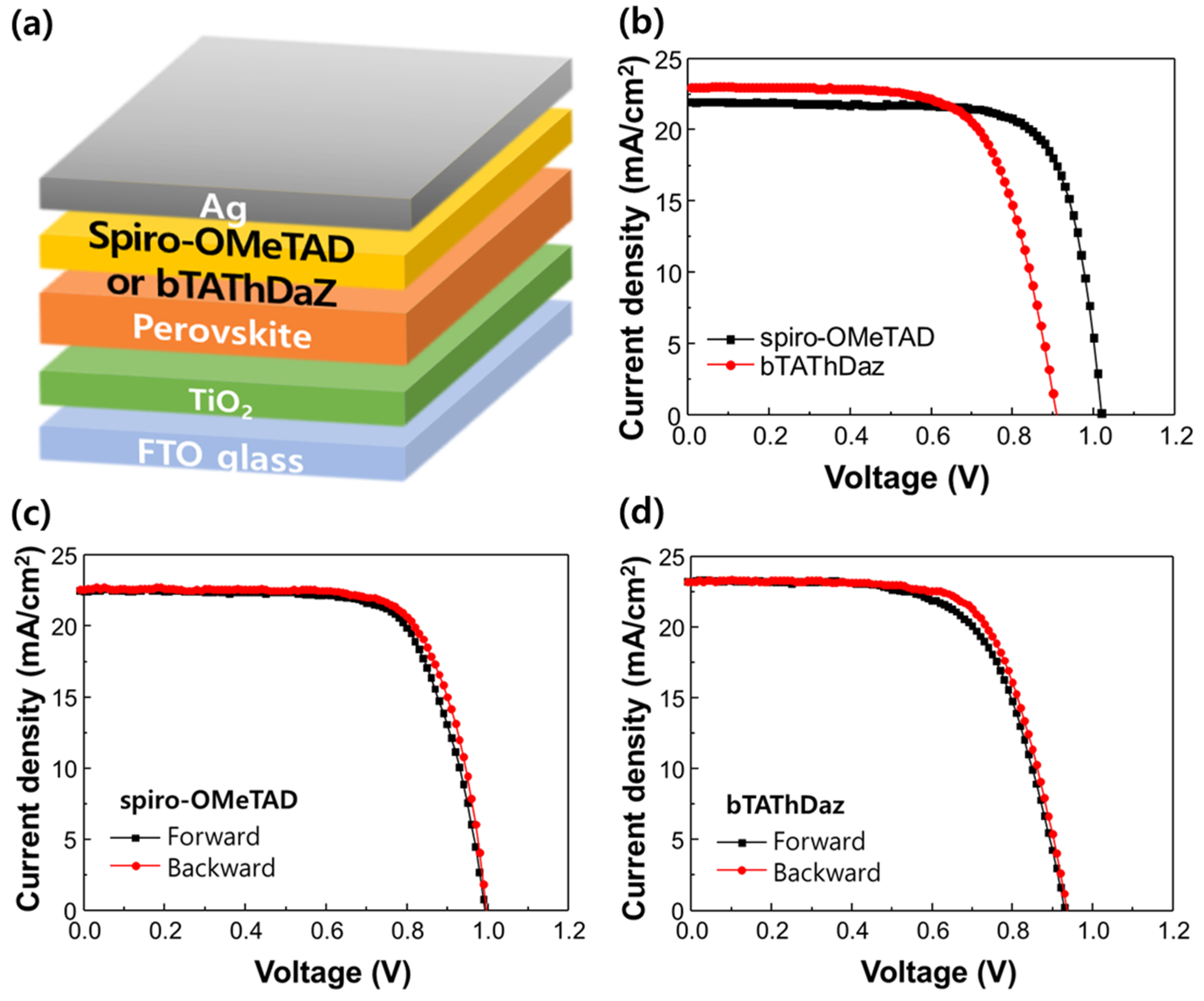
| Code | Eoxonset (V) | Eredoffset (V) | HOMO (eV) | LUMO (eV) | Eg (eV) | λabs [nm] in CHCl3 | |||
|---|---|---|---|---|---|---|---|---|---|
| CV | ER-EIS | CV | ER-EIS | CV | ER-EIS | ||||
| bTAThDaz | 0.74 | −2.05 | −5.19 | −5.5 | −2.52 | −2.3 | 2.67 | 3.2 | 247, 297, 375 |
| spiro-OMeTAD | 0.71 | −2.23 | −5.16 | −4.9 | −2.34 | −2.2 | 2.82 | 2.7 | 247, 308, 388 |
| HTM | Jsc(mAcm2) | Voc(V) | Efficiency(%) | FF | |
|---|---|---|---|---|---|
| Spiro-OMeTAD | Average (12 samples) | 21.94 ± 1.0 | 1.02 ± 0.02 | 16.88 ± 1.0 | 0.75 ± 0.05 |
| Backward | 22.57 | 0.99 | 16.54 | 0.74 | |
| Forward | 22.45 | 0.99 | 16.05 | 0.72 | |
| bTAThDaz | Average (12 samples) | 22.96 ± 1.2 | 0.90 ± 0.02 | 14.37 ± 0.8 | 0.70 ± 0.06 |
| Backward | 23.22 | 0.93 | 14.89 | 0.6 | |
| Forward | 23.23 | 0.93 | 14.05 | 0.65 | |
© 2020 by the authors. Licensee MDPI, Basel, Switzerland. This article is an open access article distributed under the terms and conditions of the Creative Commons Attribution (CC BY) license (http://creativecommons.org/licenses/by/4.0/).
Share and Cite
Bogdanowicz, K.A.; Jewłoszewicz, B.; Iwan, A.; Dysz, K.; Przybyl, W.; Januszko, A.; Marzec, M.; Cichy, K.; Świerczek, K.; Kavan, L.; et al. Selected Electrochemical Properties of 4,4’-((1E,1’E)-((1,2,4-Thiadiazole-3,5-diyl)bis(azaneylylidene))bis(methaneylylidene))bis(N,N-di-p-tolylaniline) towards Perovskite Solar Cells with 14.4% Efficiency. Materials 2020, 13, 2440. https://doi.org/10.3390/ma13112440
Bogdanowicz KA, Jewłoszewicz B, Iwan A, Dysz K, Przybyl W, Januszko A, Marzec M, Cichy K, Świerczek K, Kavan L, et al. Selected Electrochemical Properties of 4,4’-((1E,1’E)-((1,2,4-Thiadiazole-3,5-diyl)bis(azaneylylidene))bis(methaneylylidene))bis(N,N-di-p-tolylaniline) towards Perovskite Solar Cells with 14.4% Efficiency. Materials. 2020; 13(11):2440. https://doi.org/10.3390/ma13112440
Chicago/Turabian StyleBogdanowicz, Krzysztof Artur, Beata Jewłoszewicz, Agnieszka Iwan, Karolina Dysz, Wojciech Przybyl, Adam Januszko, Monika Marzec, Kacper Cichy, Konrad Świerczek, Ladislav Kavan, and et al. 2020. "Selected Electrochemical Properties of 4,4’-((1E,1’E)-((1,2,4-Thiadiazole-3,5-diyl)bis(azaneylylidene))bis(methaneylylidene))bis(N,N-di-p-tolylaniline) towards Perovskite Solar Cells with 14.4% Efficiency" Materials 13, no. 11: 2440. https://doi.org/10.3390/ma13112440
APA StyleBogdanowicz, K. A., Jewłoszewicz, B., Iwan, A., Dysz, K., Przybyl, W., Januszko, A., Marzec, M., Cichy, K., Świerczek, K., Kavan, L., Zukalová, M., Nadazdy, V., Subair, R., Majkova, E., Micusik, M., Omastova, M., Özeren, M. D., Kamarás, K., Heo, D. Y., & Kim, S. Y. (2020). Selected Electrochemical Properties of 4,4’-((1E,1’E)-((1,2,4-Thiadiazole-3,5-diyl)bis(azaneylylidene))bis(methaneylylidene))bis(N,N-di-p-tolylaniline) towards Perovskite Solar Cells with 14.4% Efficiency. Materials, 13(11), 2440. https://doi.org/10.3390/ma13112440








